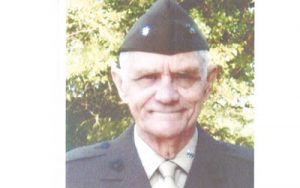 Today, June 25, 2020, marks the 70th anniversary of the start of the Korean War. Kernersville resident and retired U.S. Marines veteran Lt. Col. William S. Gerichten was there in October of that same year, serving as a machine gun section leader in D Company with the 2nd Battalion, 5th Marines.
Today, June 25, 2020, marks the 70th anniversary of the start of the Korean War. Kernersville resident and retired U.S. Marines veteran Lt. Col. William S. Gerichten was there in October of that same year, serving as a machine gun section leader in D Company with the 2nd Battalion, 5th Marines.
Gerichten penned a letter titled “The Chosin Few” that details Gerichten’s war experience in the Battle of Chosin Reservoir and his memories of the men he served alongside. Gerichten shared the pages of his letter with the Kernersville News in recognition of the war’s anniversary.
According to Wikipedia, the Battle of Chosin Reservoir, also known as the Chosin Reservior Campaign or the Battle of Jangjin Lake, began on November 27, 1950 and lasted until December 13. “The battle was fought over some of the roughest terrain during some of the harshest winter weather conditions of the Korean War,” notes the online resource.
In his letter, Gerichten begins: “In October 1950 as a Sergeant in D/2/5, I served as a Machine Gun Section Leader. There were five MG Squads, two in my section, two in a section with Sgt. John Nagy, and one with Sgt. Kenneth W. Stewart in charge. Lt. Karle Seydel was our MG Platoon Leader,” Gerichten writes.
“In all our platoon activities in the combat area, moving forward against the enemy, defensive perimeter, patrol, outposts, Lt. Seydel was an excellent leader and motivator, with deep concern for the welfare of his men, their clothing, food, ammunition, and equipment. He had a deep sense of compassion, determination and dedicated professionalism.”
He continues.
“Many suffered the ravages of the bitter cold. When my feet were frozen and developed large blisters on the heels, I was recommended for evacuation. I pleaded with Lt. Seydel to let me stay. I needed to be with my unit. He agreed. I punctured the blisters every morning but by evening the fluid had returned.
“On the morning of December 6, I recall our men climbing a steep snow covered hill, made even more slippery by those who went before us. The men carrying the machine guns, and the ammo carriers with their cans of ammunition, had a very rough time. At one point there was a thick rope that someone had set up, and it helped us all.
“Just prior to our attack along the ridgeline, Marine aircraft flew low over us searching for the enemy. My MG section was attached to a rifle platoon. As we moved forward, one of my machine gunners, Cpl. Robert Dugan, was shot in the abdominal area. He was attended to and removed to a safe location. As the company attacked and secured the hill and ridgeline, we were ordered to dig in and assume a defensive position. As always, the ground was frozen solid and our entrenching tools were poor instruments for the conditions. My MG Squads were within shouting distance of each other. For some reason, we did not believe we would be there for long. Several thought that as the motorized convoy below moved on, we would all be following not too far behind.
“Night fell, and the Marine aircraft vanished. With darkness came the anticipation and expectation of extreme cold, and the enemy. It was to be one of our longest nights. The enemy began probing and moving toward our position. There was firing from both sides, and it steadily increased. Men were being shot. Some cried out for the Corpsmen. The crack of gunfire was everywhere. In a prone position near one of my MG’s, I was firing my carbine and encouraging my men. Mortars were being fired relentlessly. Someone stood up on the line and fired a WP rocket from a bazooka. People were being hit all around us. Concussion grenades were thrown at us. You could smell the enemy. Their bodies were stacked up in front of and just below us.
“Then there was the infamous Chinese bugle call. Lt. Seydel appeared below the ridgeline and called me below. He said we were pulling back. Take your men to the next ridgeline. Bullets were cracking all around us. As he turned his body to leave, he fell over into the snow. With all the communication wire that was lying on the ground, I thought he had tripped and fallen. I bent down to reach over and help him. It was then that I realized he was dead. As I began to return to my machine gunners to inform them of our orders to withdraw, some members of the rifle platoon had already left their positions and were off the ridgeline, our defensive perimeter.
“Sgt. Jones (whom I had known for over a year from our days in D/2/5 at Camp Pendleton) told his men to ‘get back to their holes.’ They said they could not because the enemy was already in them. Collecting my two MG Squads, we pulled back with the others, firing our weapons at the enemy, dragging and helping the wounded along with us.”
Gerichten continues to detail the unfolding battle.
“As we reached the hill behind us, I saw a line of entrenched Marines and felt some relief that there were others around. I asked who they were and was told ‘Fox Company.’ With many wounded among us, we joined their defensive line. We found more ammunition and participated in the continuing firefight. The intense fighting continued but the enemy did not move on this position. Instead they poured down the valley toward the convoy intent on overrunning and destroying it. Hundreds of them met their death from small arms and mortar fire, and short fused artillery shells, and the sheer determination of the defenders.
“As time passed, I started into the darkness of the area we had vacated. I hoped for daylight and the return of our aircraft. As I continued my visual search of the battle area we had left behind, at one point I thought I saw a yellow air panel (marker) way down below, move. I strained my eyes … SAW IT MOVE AGAIN AND THEN AGAIN. Suddenly I realized that someone was alive and signaling for help. I told one of my squad leaders that I was going down below to check it out. Sgt. Stewart, another MG Section Leader, said, ‘Don’t go! It’s a trap!’ I insisted on going. An officer nearby then agreed that it looked like the panel had moved, and could be a live Marine. He said I could go if I could get three others to go with me. PFC Decker, one of my machine gunners and two others joined, and we spread out and went below. It was then just barely light. Because of the steep and irregular contour of the hillside, I soon lost sight of the others. My weapon and I were ready for anything.”
Gerichten did indeed find a fellow Marine, he writes.
“Suddenly there appeared before me, in a small stand of bare bushes, a Marine with a yellow air panel standing alone. His abdominal area was blood red, covered with ice crystals. His bare head had a deep gash but was not bleeding. His parka, gloves, boots, headgear, and weapon had been taken from him. I’m sure the enemy had thought he was dead. I asked if he was alone or if anyone else was in the area. No response. I told him I’d be back as soon as I looked for any others.
“I made it to the top of the ridgeline we had left earlier that night. No live enemy was to be found. By then it was daylight. I waved back to our lines that all was clear. Returned to the man I had found and remained with him, as others came down the hillside. There were many dead. Most all had their cold weather clothing removed.
“Then I saw Lt. K. Seydel. His unshaven white face revealed a red beard of sorts. I felt complete sadness in the loss of this fine officer, and all he had meant to us. I accompanied the wounded man I had found, back to our front lines. As he lay on the ground, his body now covered, someone put a lighted cigarette in his lips. It quickly fell over to one side of his mouth. As he raised his hand to straighten it, I saw that all his fingers were white and frozen together. Another scene I will never forget. Believe his name was “Ski” something, from Baltimore. I have always wondered what his name was, and how well he survived.
“Someone pointed out that my face had yellow/tan dust on it. Must have come from the grenades that were thrown at us that night. The wooden stock of my carbine had marks where bullets had struck it. This may have occurred when Lt. Seydel was bringing me the word to pull back, the time he was killed.
“We later continued our march to the sea, with other battles remaining on the horizon.
“Semper Fi.”
Gerichten noted later that the man’s name who he had found was Preston Harry Hommerbocker and that he did find his home, but was told by his son that Hommerbocker had died recently. Gerichten also pointed out that what might have been a fatal gunshot wound to his chest was miraculously averted by a Bible that was in Hommerbocker’s pocket.
Gerichten was a member of the U.S. Marine Corps from 1946 to 1973. A Purple Heart recipient, Gerichten fought in the Korean War from 1950-1953.
Remembering the Korean War
Previous post: Remembering the Korean War
Next post: Sunflower farms









